Maintaining high financial data quality is essential yet challenging. Issues like data silos and legacy systems often impede accuracy. This article dives into transforming financial data quality with PIM and advanced analytics. Learn how PIM centralizes data, and advanced analytics turns it into actionable insights, directly impacting decision-making and compliance. Start your journey to better data management here.
Importance of Product Data Quality in the Financial Sector
Data quality is the lifeblood of the financial sector. Ensuring regulatory compliance and accurate reporting hinges on the integrity of the data managed by financial institutions. Imagine trying to make critical business decisions based on flawed data; the ramifications could be catastrophic. Common challenges like data silos, inconsistencies, and errors, often exacerbated by legacy systems, make maintaining high data quality a formidable task.
The risks associated with poor data quality are significant. Flawed decision-making and compliance risks can lead to severe penalties, not to mention a loss of trust from stakeholders and clients. This is where robust data governance comes into play. Implementing stringent data governance practices ensures accountability and aids compliance for financial institutions. PIM solutions are instrumental in this regard, as they provide the necessary framework to enhance data quality effectively.
In essence, accurate product data and high data quality are not just operational requirements but strategic imperatives. Addressing common data quality challenges and leveraging PIM paves the way for reliable and insightful data management, ultimately driving better decision-making and compliance outcomes for financial institutions.
Understanding Product Information Management (PIM)
Product Information Management (PIM) is a game-changer in the realm of data management. At its core, PIM centralizes and manages product information, ensuring data accuracy and consistency across various channels. Think of it as the nerve center for all your product data management, seamlessly integrating with systems like ERP, ecommerce platforms, and print catalogs to maintain a single source of truth. Additionally, product information management systems are crucial solutions for effectively managing product details across various channels, emphasizing the necessity of a centralized repository for product data.

The benefits of implementing PIM solutions are manifold. Businesses can achieve:
- Operational efficiency
- Shortened time-to-market
- Enhanced customer experiences
- Revenue growth
For instance, ecommerce managers and brands can rely on accurate product data and customer relationship management to ensure their online shops and catalogs reflect the most current information across various sales channels, thus avoiding costly errors and improving customer satisfaction.
Beyond just data management, PIM systems deliver accurate and complete product information, crucial for effective decision-making and responsiveness to market demands. Leveraging PIM allows organizations to streamline product lifecycle management, digital asset management, and overall data governance, ensuring consistent product data quality.
Read More About – PIM Adoption and Trends
How PIM Works
A PIM system works by collecting product information from various sources, such as suppliers, manufacturers, and internal teams, and centralizing it in a single location. The system then organizes and structures the data, making it easily accessible and manageable. PIM systems also enable businesses to enrich product data with additional information, such as product descriptions, images, and videos, and localize it for different markets and languages. Finally, the system distributes the product data to various channels, ensuring that accurate and consistent information is available to customers across all touchpoints.
For instance, a PIM system can pull product specifications from a manufacturer, marketing descriptions from internal teams, and images from a digital asset management system. It then consolidates this information, allowing businesses to create a comprehensive and enriched product profile. This profile can be tailored to meet the needs of different markets and languages, ensuring that customers receive relevant and accurate information regardless of where they are shopping.

Benefits of Using a PIM System
Using a PIM system can bring numerous benefits to businesses, including improved data quality, enhanced customer experience, and increased efficiency. By centralizing product information and ensuring data accuracy, businesses can streamline their operations and provide a better experience for their customers.
Improved Data Quality
A PIM system helps businesses to improve data quality by providing a single source of truth for product information. This ensures that accurate and up-to-date data is available to customers and stakeholders, reducing the risk of errors and inconsistencies. By centralizing product data, businesses can also eliminate data silos and ensure that all teams have access to the same information.
For example, when product data is scattered across different departments and systems, it can lead to discrepancies and errors. A PIM system consolidates this data, ensuring that everyone in the organization is working with the same accurate information. This not only improves data quality but also enhances collaboration and efficiency.
Enhanced Customer Experience
A PIM system enables businesses to provide an enhanced customer experience by delivering accurate and consistent product information across all touchpoints. This includes product descriptions, images, and videos, as well as technical data and specifications. By providing customers with a seamless and consistent experience, businesses can increase customer satisfaction and loyalty, ultimately driving sales and revenue.
By implementing a PIM system, businesses can also improve their marketing efforts by providing marketers with accurate and up-to-date product information. This enables marketers to create targeted and effective campaigns, increasing the chances of converting leads into sales.
In addition, a PIM system can help businesses to improve their sales channels by providing sales teams with accurate and up-to-date product information. This enables sales teams to make informed sales decisions and provide customers with the information they need to make a purchase.
Overall, a PIM system is a crucial tool for businesses that sell products through multiple channels. By providing a single source of truth for product information, improving data quality, and enhancing the customer experience, a PIM system can help businesses to increase efficiency, drive sales, and revenue, and ultimately achieve their goals.
Learn more about PIM and its usability in various industries using our PIM Insight Report
Advanced Analytics Techniques in Finance
Advanced analytics in finance is akin to having a crystal ball, revealing hidden patterns and enhancing predictive accuracy through complex algorithms. Real-time monitoring is vital for immediate anomaly detection, helping maintain operational efficiency. For example, predictive modeling, often enhanced by machine learning, plays a crucial role in risk assessment and mitigation, allowing financial institutions to make informed decisions.
Visualization techniques further empower finance professionals by enabling quick detection of data trends and anomalies, facilitating informed decision-making. Machine learning is increasingly leveraged for predictive analytics, helping organizations assess risks more accurately and make smarter lending decisions. Integrating these advanced technologies can significantly enhance data-driven decision-making and operational efficiency.
Key advanced analytics techniques include anomaly detection, trend forecasting, and predictive modeling, all of which are essential for data-driven strategies. Utilizing these techniques allows financial institutions to transform data into actionable insights, driving strategic initiatives and securing a competitive edge.
Synergy Between PIM and Advanced Analytics
Integrating PIM with advanced analytics creates a powerful synergy that significantly enhances product data quality. A well-structured PIM system provides a structured framework for data management, centralizing data and enabling efficient scaling. This integration is not just about data storage; it’s about transforming data into a strategic asset that can drive business growth.
The combination of PIM and advanced analytics eliminates data silos, fosters data enrichment, and enhances customer experience. Implementing a cloud-based PIM solution allows organizations to manage increasing product data efficiently as they expand.
The following subsections explore how this synergy enhances data collection and cleansing, and generates insightful analytics.
Enhancing Data Collection and Cleansing
PIM systems automate the process of standardizing product information, significantly reducing manual input errors during data entry. Consistent data entry practices ensure that organizations maintain accurate and reliable product data. This automation also streamlines data cleansing, ensuring that only validated and enriched product data is utilized for analysis, including the use of pim software.
Moreover, PIM fosters collaborative workflows through a centralized system, enabling teams to access shared product data and enhance cooperation. This not only accelerates data verification but also ensures timely updates to product information, thereby reducing inefficiencies and boosting overall data quality.
Generating Insights Through Analytics
Advanced analytics tools can utilize centralized PIM data to derive actionable insights that inform financial strategies. Clean and organized data from PIM systems allows analytics platforms to deliver accurate performance metrics and trends, supporting strategic initiatives. This integration enables the uncovering of trends and patterns that might otherwise go unnoticed, providing a competitive edge.
Integrating analytics tools with financial data sources provides deeper insights, allowing financial institutions to make informed decisions based on comprehensive data analysis. These insights enhance marketing channels, customer segments, and overall customer experience, ultimately driving business growth for organizations.
Implementation Strategies for Integrating PIM Systems and Advanced Analytics
Implementing PIM and advanced analytics requires a strategic approach. It begins with identifying clear goals, assessing current data quality, and establishing a timeline for implementation. Continuous monitoring and validation of data post-migration are necessary to maintain data quality and integrity. Achieving integration flexibility is crucial, as it enhances the productivity of a PIM system when it connects seamlessly with existing software.
Financial institutions must also invest in advanced security measures powered by AI to combat sophisticated fraud techniques and ensure transaction safety. Adopting these strategies enables successful integration of PIM and advanced analytics, driving operational efficiency and enhancing customer experience.
Ensuring Scalability and Security
Ensuring scalability requires planning for growth by designing systems that can handle increased data loads without performance degradation. Automation capabilities in PIM support tasks such as data clean-up and corrections, improving the efficiency of financial data management. Machine learning applications in finance further enhance security by automating data validation, leading to increased accuracy in financial reporting.
Implementing comprehensive security measures is crucial to the success of PIM and advanced analytics integration. Focusing on scalability and security ensures that data management systems remain robust and reliable as organizations expand.
User Adoption Best Practices
Effective adoption of new PIM systems often hinges on providing comprehensive training and fostering a sense of ownership among users. Comprehensive training programs address user needs, skill gaps, and encourage familiarity with the new PIM and analytics systems. Engaging stakeholders early in the PIM implementation process can significantly enhance user buy-in and adoption rates.
Prioritizing training and stakeholder engagement drives higher rates of user adoption for PIM and analytics systems. This ensures that the new systems are utilized to their full potential, ultimately enhancing customer experience and operational efficiency.
Steps to Begin Your Transformation Journey
Embarking on a transformation journey involves several critical steps. Obtaining senior management endorsement for PIM systems often hinges on demonstrating potential reductions in costs and improvements in operational efficiency. A clear vision from leadership, effectively communicated throughout the organization, is essential for a successful digital transformation.
Promoting collaboration across different departments and external partners is crucial for achieving better market reach and fostering innovation during transformation. Building a culture of innovation empowers employees to embrace new technologies and improve their competencies, ensuring the success of the transformation journey.
Summary
In summary, integrating PIM and advanced analytics can significantly enhance financial data quality, driving better decision-making and compliance outcomes. By addressing common data quality challenges and leveraging the synergy between PIM and advanced analytics, financial institutions can transform their data into a strategic asset.
As you embark on your transformation journey, remember that the key to success lies in planning, continuous improvement, and fostering a culture of innovation. Embrace these tools and strategies to elevate your financial data management and drive business growth.









































